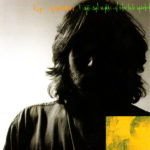
American Clavé. What a name. Kip Hanrahan is one of those musicians that deserves, mightily, to be a large household name, but for reasons unbeknownst to me, never quite could break that final barrier. No matter how perfect his blend of outsider jazz and instantly “getable” ideas were. We’re worse off as a music culture that we remain lost to what he tried to do in those earlier, golden days. Days And Nights Of Blue Luck Inverted had all the makings of something that should have launched him out of the jazz ghetto but no matter how many styles he refashioned and mutated, none of them caught into the greater sphere of culture. Our loss, as they say…
Kip’s musical life began in a Boricuan neighborhood in the Bronx. From a young age absorbing its Latinx culture, African and Caribbean diaspora, when it was his turn to create music, it was his own music that spoke of all those influences creeping into the crevices of his own Irish-Jewish American background. If his music sounded like it was of city life, it was because New York City itself formed the basis of his mercurial explorations.

Out in Bedford Park it was the music blasting out of cars and homes that he’d admire as he played soccer with the kids in the hood. Music, though, wouldn’t be where he thought of himself as ending up creating. Once grown, he’d pursue the arts through sculpture and crafted works, going so far as working under the tutelage of famed artist Hans Haacke.
It wasn’t until he studied abroad, sometime in the late ‘60s, and ran into the music of the Jazz Composer’s Orchestra (featuring one Carla Bley) that he took a job in the collective’s production office and learn the ins/outs of record production, distribution, and promotion. In the late ‘70s, he’d come back to NYC and establish his record label, American Clavé, as a means to distribute jazz music that was destined for the cutting room by trumpeter Jerry Gonzalez.
It wasn’t until 1981 that Coup de Tête, a collection of ideas he couldn’t flesh out with Jerry, became what would be his debut. Realizing his strength as a facilitator, on releases either by himself or others he’d sign on his label, here we get his talent of bringing the right people — Bill Laswell, Arto Lindsay, and Carla Bley, to name a few — to push new angles in lesser explored music. It’s music that any F/S listener would enjoy as it uses “world music” as a launching point for a lot of leftfield ideas.
By the time of 1987’s Days and Nights of Blue Luck Inverted, from 1983’s Desire Develops An Edge to it’s followup Vertical’s Currency we’ve started to hear Kip’s house sound which is what made his contributions to music so different and necessary. Project like Conjure with Allen Toussaint, Steve Swallow, Leo Nocentelli, and Taj Mahal, captured his flowering reimagining of jazz music (seen far from the anglo-centric world). Luckily, as his ideas became more and out there, somehow they acquired equal doses of romanticism.
Should have been late night burners like “Make Love 2” sung by Jack Bruce, affirmed how close to the streets his music could be, even as those hits couldn’t quite bubble over. On the works of others, perhaps, musicians like him would get lost in experiments. With Kip, by hook or by crook, he had a vision that kept them intently focused on the task at hand.
For all the years Kip nearly went bankrupt releasing his own work, the works of others like Astor Piazzolla, Teo Macero, DNA, Ishmael Reed, and paying for all his session musicians, it wasn’t until one Sting came knocking that there could have been a chance for others to finally get with his ideas. There was a time when PANGÆA was supposed to use Kip’s American Clavé reissues as a launching point for Sting’s vision of a new kind of world music record label. Heaven knows why his own Days And Nights Of Blue Luck Inverted couldn’t do it.
I do have my suspicions. The very adult way he captured sex, relationships, and personal peccadilloes might not have been something others were accustomed to. In the music of Lou Reed, Leonard Cohen, etc. we had glimpses of what Kip brought here in “rock” — but here you have them tied to all sorts of rhythm (latin jazz, tango, deep funk, and more) that’s mutated into a darker vibe that’s just as urbane and prophetic.

If you can imagine a radio station that can play something like “Marriage” or “Lisbon: Blue Request”, perhaps you are of this era and not his. Perhaps we’re more in tune now to get what Kip truly was after. Although not one song on Days and Nights of Blue Luck Inverted sounds like any other, there is some tie holding it altogether. It’s as American as bean pie. Perhaps it’s not Kip that’s the problem — that’s on us.
